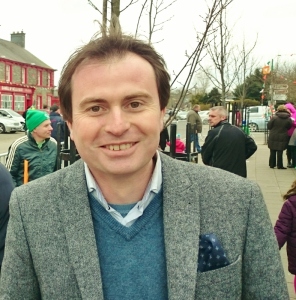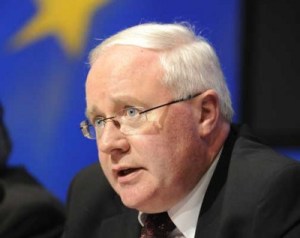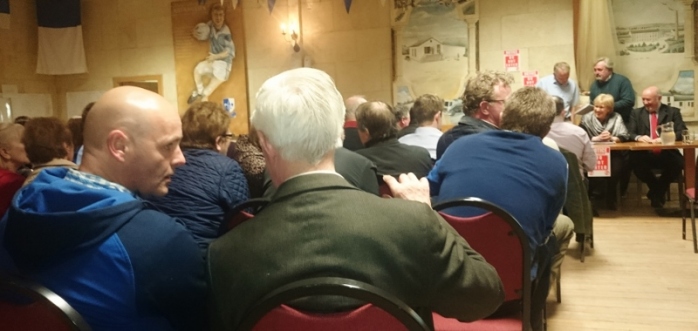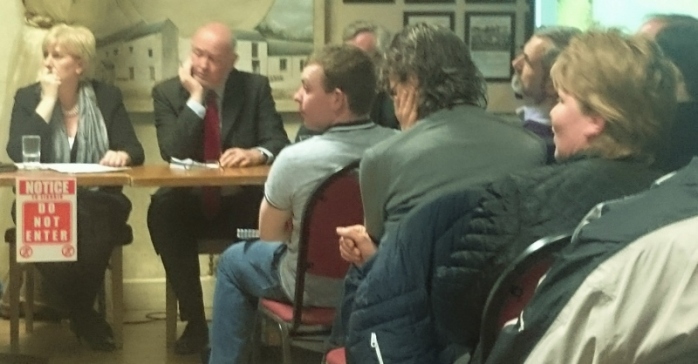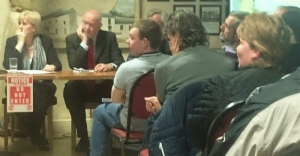
Heather Humphreys T.D. and Caoimhghin Ó Caolain T.D. at the anti-pylons meeting in Aughnamullen Social Centre Photo © Michael Fisher
PACKED MEETING TELLS EIRGRID: MAKE THE INTERCONNECTOR UNDERGROUND
Michael Fisher Northern Standard Thursday 23rd April p.16
It’s a controversial issue and feelings were running high at times. After nearly three hours a clear message emerged from the crowded hall in Aughnamullen Social Centre in Lough Egish on Monday night. The verdict of the meeting was that EirGrid’s proposed second North/South electricity interconnector must be put underground. Over 300 people attended the meeting organised by the County Monaghan anti-pylon committee. After hearing from four of the five local TDs and then a lively question and answer session, a motion was put forward by Fianna Fáil Councillor Seamus Coyle. It was seconded by Fine Gael Councillor Hughie McElvaney.
The motion instructs TDs to place a Dáil motion asking the government to instruct EirGrid to cease all work on the proposed North/South link and to direct Eirgrid to underground fully the North/South interconnector as a high-voltage direct current (HVDC-VSC) cabling along roads, as in the company’s proposal for a section of the GridWest link. Asked by a member of the large crowd if she supported the motion, local Fine Gael T.D. and Minister for the Arts, Heritage and Gaeltacht, Heather Humphreys said she would take time to read the motion before she agreed to it.
Deputy Sean Conlan said he would be bringing the motion to a meeting of the Fine Gael Parliamentary Party at Leinster House due to be held last night (Wednesday). Sinn Féin TD Caoimhghin Ó Caolain and Deputy Brendan Smith of Fianna Fáil also contributed to the meeting and there was an apology from Joe O’Reilly T.D. and Matt Carthy MEP.
COUNCILLORS PRESENT
Thirteen of the eighteen Monaghan Councillors were present, including all six from the Carrickmacross-Castleblayney Municipal District. An apology was received from Cllr Cathy Bennett. Concerns raised during the meeting that lasted nearly three hours ranged from the potential health impact of the overhead line, the devaluation of people’s land and property if the proposed project goes ahead and the environmental impact and unsightliness of the pylons. Many speakers claimed that the people of Monaghan, Cavan and Meath were being treated as second class citizens compared to those living in areas that would be affected by EirGrid’s two other major supply projects, GridWest and GridLink. They said communities in County Monaghan had not been consulted by EirGrid about a possible underground option for the 140km line, which the company has estimated would be five times more expensive than the overhead plans.
The meeting was opened by the Chairman of the Anti-Pylon Committee, Donal McDaid. He said it was probably the most important meeting ever to be held in this community in recent times. It might well decide for the next 100 or 200 years whether they would have a blight on the community for generations to come. He said if the proposed planning application by EirGrid ended up in the courts then the cost to everyone would be twice as much.
A planning application for the proposed interconnector route from Meath to Tyrone will shortly be put before An Bord Pleanála by EirGrid. Nigel Hillis set out the timetable of developments in the project since their last public meeting in January last year. He said if the planning application was lodged in May, with a seven weeks period for formal consultation, it was possible there would be an oral hearing held in September or October.
Each of the TDs present was given an opportunity to comment on the situation. Seán Conlan T.D. said land owners had made it clear they wanted the link put underground. Minister for the Arts, Heritage and the Gaeltacht Heather Humphreys T.D. told those present she supported them, but they must understand that she was limited as a Minister as to what she could do. Responding to a call by her party colleague Seán Conlan that she should veto at the Cabinet table any EirGrid decision on an overhead route for the interconnector, she said there was a misconception about her role in Cabinet and emphasized that she did not have any such veto. But if the issue was raised at Cabinet, then she would be making her views known.
The Minister said she had already raised local concerns with the Taoiseach, the Energy Minister Alex White T.D. and within the Fine Gael Parliamentary Party. “All I want is fair play and equal treatment for the people of this area”, she said. She repeated what EirGrid had said, that the proposed interconnector was a strategic and critical addition to the grid, allowing the operators on both sides of the border to operate a single market for electricity. The power requirements for the West and South-East of the country were different, she said. The Minister said she was in attendance to listen to the concerns of local people.
Sinn Féin T.D. Caoimhghín Ó Caolain told the meeting there had been a persistent refusal by EirGrid to engage properly on the proposed route. It would take the resolve of the local people and the support of political voices to change any decision. He would work with the committee and its supporters in passionate opposition to what was proposed.
Fianna Fáil T.D. Brendan Smith said the South East and West of the country were being treated differently from the North-East. The people of Cavan/Monaghan were not being offered the same treatment in the GridWest and GridLink options, which allowed for possible underground power lines. He would continue to lobby to have the interconnector put underground and would be conveying the concerns expressed at Tuesday’s meeting of the Joint Oireachtas Committee on Transport and Communications.
Terry Lynch from Ardragh, Corduff, whose family farm would be affected by one of the proposed pylons, claimed that they were being treated a second class citizens. He asked the speakers at the top table: “What are you going to do about it?” He said 400kV cables were being undergrounded all around Europe, across London, Madrid and even China and wondered why it could not be done in Ireland. “What kind of state are we in?”, he asked.
Naoise Gordon from Annyalla who lives adjacent to the proposed line asked Minister Heather Humphreys why the government was not supporting a clean and affordable underground option for the interconnector. Jim McNally, also from Annyalla, pointed out the effect it would have on the small farm homesteads in the area, many of them occupied by elderly residents.
The IFA Chairman in County Monaghan Brian Treanor told the meeting the Association’s position over the years had been very consistent since the project was first mooted in 2008. They would represent any farm families when EirGrid presented all its options, properly costed, to An Bord Pleanála, and the planning authorities would make the decision, which he hoped would be the right one. They needed to have all options on the table, he said. Mr Treanor said the farmers’ group was not anti-progress and they wanted to see development. He wondered if a smaller 250kV project was required, and whether there was a need for a high voltage interconnector to the North. There was a huge responsibility on EirGrid, he said, to do the least damage to the farm environment and to farm families. In response to criticism from the floor, he said the IFA had always demanded that EirGrid looked at all the options, but the IFA were not technicians or experts. They were demanding that best practice be operated.
The chair of the meeting Alan McAdam pointed out that over 90% of farmers on the proposed route were IFA members and they were against having pylons on their land. Patrick Lynch from Corduff asked who would want to buy any property where a pylon was situated: it would be left valueless. He claimed elected representatives had been shirking their responsibility.
In his closing remarks the Anti-Pylon Committee Chairman Donal McDaid said it was possible to get the government to change policy, as had been done when pressure was put on former Minister Pat Rabbitte T.D. over Irish Water. He re-iterated that people in Monaghan were being treated as second-class citizens. It was the duty of the Oireachtas to protect the Constitution and to ensure that all people were treated equally, he said. It was the duty of government to see to it that people in this community were not treated as second-class citizens. They wanted answers and an assurance that the government was prepared to protect the Constitution. We do not want to stop progress, but we do want justice, he concluded.
At the end of the meeting all present stood and observed one minute’s silence in memory of the anti-pylons campaigner, the late Councillor Owen Bannigan from Loughmorne, Castleblayney, who was described as ‘a giant of a man’. A vote of sympathy was passed to the local Fine Gael organization and to Mr Bannigan’s family. His son Councillor Eugene Bannigan was among those present.
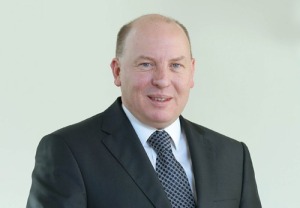
EirGrid CEO Fintan Slye Photo: http://www.agendani.com
EIRGRID CHIEF’S STATEMENT TO OIRECAHTAS COMMITTEE
On Tuesday, EirGrid’s Chief Executive Fintan Slye gave evidence to the Oireachtas Joint Committee on Transport and Communications in Dublin. Mr Slye was accompanied by Rosemary Steen, director of public affairs, John Fitzgerald, director of grid development and Aidan Geoghegan, EirGrid’s project manager on the North-South interconnector.
Fintan Slye outlined the history of the project thus far. He said that last month the company published a draft strategy for the development of Ireland’s transmission grid and was now seeking public feedback. It was shaped by three key pillars, namely open engagement with communities, making the most of new technologies and a commitment to make the existing grid work harder before building new transmission infrastructure. The strategic review included an independent report from Indecon which showed that investment in the electricity grid would directly benefit Ireland’s economy and could help to reduce energy costs. A modern transmission grid, he said, would put Ireland in a strong position to continue to attract foreign investment and support new and emerging opportunities in the energy sector. This approach would also support Ireland’s current policy objectives, including the government’s Action Plan for Jobs and the IDA’s regional development strategy.
He said the review showed there remained a clear need for the North-South interconnector project and that a 400 kV overhead line remained the most appropriate solution, linking a substation in Woodland, County Meath, with a new substation in Turleenan, County Tyrone. It would provide a second high capacity transmission line between the Republic and Northern Ireland. The project would more than double the power transfer capacity between North and South, thereby improving the efficiency of the all-island electricity market. It would enhance the security of the electricity supply throughout the island of Ireland, which Mr Slye said was essential for economic growth, the creation of jobs and improving the standard of living and quality of life for all. It would also enable more renewable energy supplies to be connected to the network.
Mr Slye said the interconnector was needed now, as a cross-border bottleneck had developed on the all-island electricity system, which was having serious financial consequences. Last year the Economic and Social Research Institute reported that the second interconnector would remove the bottleneck and reduce electricity costs by €30 million per year. The proposed scheme had been the subject of public scrutiny and debate for some time, with the focus on whether it could be put underground.
Several independent reports on the issue have been published. The government-appointed independent panel, headed by Mrs. Justice Catherine McGuinness, acknowledged that the evaluation of undergrounding of the North-South interconnector was compatible with the methodologies being employed on the Grid West and Grid Link projects. Two themes emerge from all the reports, the most prominent of which was the finding that undergrounding the project would be more expensive. The international expert commission’s report concluded that an underground solution would be three times more expensive than an overhead option. 
Mr Slye said that EirGrid’s own estimate was that an underground system for the North-South route would cost in excess of €500 million more than the overhead option. As a state-owned company the mission of which was to develop, maintain and operate a secure, economical and efficient transmission system, this was an additional cost EirGrid could not pass on to consumers. It was an additional cost that would not be acceptable to the Commission for Energy Regulation.
Whilst undergrounding was the only technically feasible option available for the East-West interconnector, the same could not be said for the North-South interconnector project. There were technical options to be considered and they had been, Mr Slye told the Committee.
EirGrid has recently republished its proposed line route that will form the basis of a planning application in the coming weeks to An Bord Pleanála. The company had been liaising with the board on the application for some months and had been doing so because eighteen months ago the European Commission designated the interconnector a project of common interest. This meant that the project was subject to a new EU regulation for trans-European energy infrastructure that was designed to facilitate a more efficient permit granting process. An Bord Pleanála was designated as the competent authority for managing the PCI process in Ireland and, in accordance with the EU regulation, EirGrid submitted a draft application file to it for review. Last month we submitted additional information to the Board which it is now reviewing, he said. Once it is satisfied with the draft application, it will draw up a schedule for formally submitting the planning application and the company expects this to happen very soon.
Mr Slye said open engagement with communities was a key pillar of the draft strategy. During the course of the project the company had endeavoured to meet every landowner affected by the development and had had productive discussions with many. Others have chosen not to deal with EirGrid directly, appointing intermediaries to represent them. This was their undoubted right and prerogative but was also a barrier to effective engagement and the company encouraged all landowners to talk to them.
Offices have been opened in counties Meath and Monaghan (Carrickmacross) and a new office would open shortly in Cavan. Mr Slye said they were encouraging anyone interested in the project to call in and discuss it with the project team. These offices would remain open right through to the submission of the planning application and afterwards. EirGrid staff will be on hand in the local offices to provide assistance for landowners and members of the public who wish to make a submission to An Bord Pleanála once the statutory consultation process starts following the submission of the planning application.
Concluding his statement, Mr Slye said the North-South interconnector was critical to ensuring a safe, secure supply of electricity throughout the island of Ireland. It would bring major cost savings and address significant issues around security of electricity supply, particularly in Northern Ireland.
LOCAL TDs RESPOND TO EIRGRID CHIEF’S STATEMENT
The first of three local TDs to be given an opportunity at the Oireachtas Committee to question the EirGrid Chief Executive Fintan Slye was Fine Gael Deputy Seán Conlan.
He said the communities in Cavan-Monaghan were very concerned that they had not been treated in the same fair and equitable manner as people in Grid Link and Grid West. There was a fundamental difference in the way they had been treated in terms of consultation compared with the people in the West and South. His constituents did not feel that they had been treated equally with people in other parts of the country. He said he had presented a petition from 95% of the landowners affected to the Minister for Communications, Energy and Natural Resources, Alex White T.D. They want a specific underground route option and they want to be consulted on it, he said.
He mentioned the meeting attended by around 350 people on Monday night in Aughnamullen community centre and said they were all totally opposed to the overgrounding of this project. There is huge community disquiet about the approach taken by EirGrid, he told the Committee. He also said there was no regional gain in Cavan or Monaghan from the interconnector project because the company had not included any converter stations. EirGrid had pointed out for the first time (in Mr Slye’s answers) that it was technically feasible to put the project underground for the 140km length of the line and that was welcome.
The company has said that it will take €500 million more to put it underground than the cost for overground. A number of questions were asked at last night’s meeting about the fact that the valuation of property has not been included in the cost of the overground option when compared with the underground option. There was also the question of the effect on tourism in the region if the lines were put overground. Deputy Conlan said Mr Slye had stated that the project was needed in its current form because of bottlenecks between transfer of energy between the North and South. But it was his understanding that the daily flow of electricity between the North and South was between 150 MW and 170 MW and that based on the company’s own figures and safety requirements, the current interconnector could take a capacity of 400 MW per day, but only 150 MW to 170 MW was being used at a maximum at tea time while the average is around 100 MW per day. There are three power stations in Northern Ireland producing up to 2,300 MW of energy per day. The average daily consumption of energy in Northern Ireland is 1,200 MW to 1,300 MW. They can produce 2,300 MW per day. The maximum daily use ever of energy in Northern Ireland was 1,700 MW in December 2010 during the very bad weather, Deputy Conlan pointed out.
He went on: “Mr. Slye said there was consultation but the question I asked was why there was no public consultation about underground routes in the North-South project.
Mr Fintan Slye: Correct.
Deputy Seán Conlan: So there was not?
Mr Fintan Slye: The underground routes were published and made available but there was not a specific consultation on an underground route. The Deputy is right. However, a specific underground route was examined and published. Members who have looked at the back of the PB Power report will see an Ordnance Survey map that sets out the route corridor.”
Mr Slye said EirGrid was proposing a community fund for the wider community and also a proximity allowance payable to householders in recognition of the fact that transmission infrastructure had a greater impact on those immediately adjacent to it in terms of their visual amenity. Responding to Mr Conlan he said:
“The Deputy raised the issue of bottlenecks in the current flow of the existing line, power capacity in Northern Ireland and projections for security supply in Northern Ireland…The Generation Capacity Statement, published every year and it approved by the regulators North and South clearly articulates the security supply issue that (would be) emerging in Northern Ireland in 2020 as security of supply margins dip below what is acceptable. That is due in part to the impending closure of some of the power stations in Northern Ireland. Security of supply is incredibly important to business, industry and the economy. Hence, reliance on the single line between North and South is limited by the fact that it is a single line and any one thing could potentially take it out of commission”, Mr Slye said in his response.
Deputy Conlan said the most significant point made by Eirgrid in his view was Fintan Slye’s admission that there had been no public consultation about any specific underground routes for the North- South interconnector. The international expert group had already reported in 2012 that undergrounding was feasible.
In a comment to The Northern Standard after the Oireachtas Committee engagement with Eirgrid’s Chief Executive, Sinn Féin Deputy Caoimhghín Ó Caoláin said that important acknowledgments were made and other important questions had yet to be answered. “Mr Slye’s acceptance that an undergrounding approach to the North-South interconnector project is both ‘engineering and technically possible’ is important and is now firmly on the record” stated Deputy Ó Caoláin. “His comments regarding ‘other advantages’, though unspecified, and that consideration of the underground option was not just about cost was also important. The acknowledgement in answer to Deputy Conlan that “no underground route consultation with the public” had taken place regarding the North-South project was also an important confirmation of a truth the public had all known.
“I am awaiting response to other questions I posed and additional detail, including regarding the estimated additional cost per consumer per annum, and over what timeframe, if the underground option is to be proceeded with. Mr Slye’s initial response suggested a 3% to 5% increase in the cost per consumer, with a likely greater cost being placed on non-domestic customers. Having already stated on the public record that I would be prepared to accept an additional cost as a domestic consumer rather than have my neighbours and friends across the path of Eirgrid’s planned pylon supported project suffer the imposition of these monstrosities, I am keenly interested to explore Mr Slye’s calculation. The bottom line from this encounter is that Eirgrid are under no pressure from this government regarding the North-South interconnector project proceeding as Eirgrid intends. Until senior government voices make it abundantly clear that the underground option is the only way to proceed, then Eirgrid will keep to its plan”, concluded Deputy Ó Caoláin.
Fianna Fáil Spokesperson on Border Region Development Brendan Smith TD commented that a very important statement had been made at the Oireachtas All-Party Committee by the Chief Executive of Eirgrid. He said Fintan Slye had confirmed, in response to a question from the Fianna Fáil Energy Spokesperson Michael Moynihan TD, that the undergrounding of the North/South Interconnector was feasible in terms of engineering”.
Speaking to the Northern Standard Deputy Smith explained: “I outlined to the Eirgrid Chief Executive that there had been no meaningful discussions with local communities, that there was very serious concern and anger among communities in Monaghan, Cavan and Meath arising from the government’s decision to press ahead with the construction of overhead power lines for the North-South interconnector, despite carrying out a review of the other two GridLink and GridWest projects. The people of the North- East will not allow themselves be treated as second-class citizens and will continue to demand an examination of the current proposals”, he said.
“In 2009 it was estimated that undergrounding the cables would cost more than 20 times the cost involved in keeping these transmission lines above ground. This cost argument has been totally diminished and it is now widely accepted that the costs in laying the cables underground is now less than 1.7 times the cost of overgrounding.
The Cavan-Monaghan TD stated, “It is reprehensible that EirGrid are not factoring in the devaluation of land, the severe break-up of farm holdings, major disruption to households and the threat to the entire tourism and heritage landscape”.
Representatives of the County Monaghan Anti-Pylons Committee will appear before the Oireachtas Committee next Tuesday 28th April, at 11:30am when it’s expected they will respond to the EirGrid submission. The hearing can be watched on Oireachtas TV.

